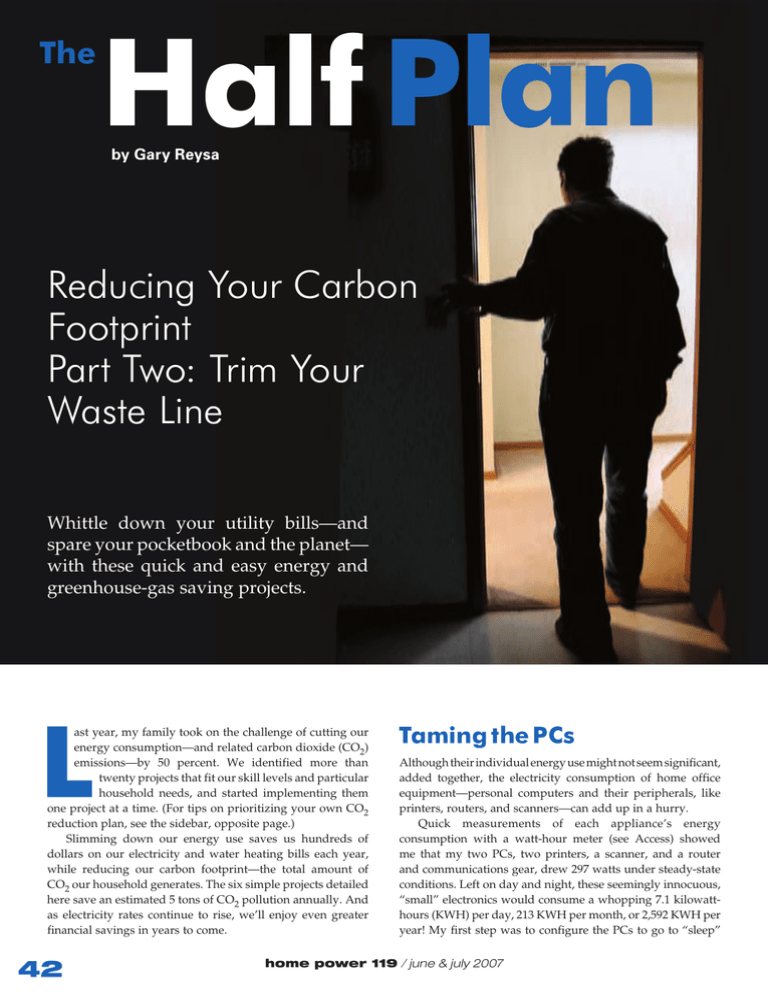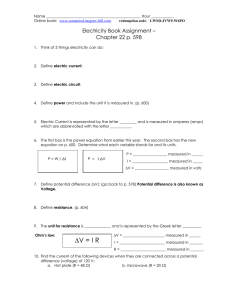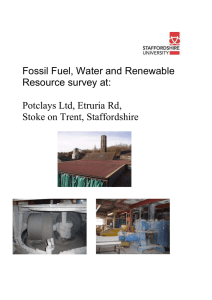Reducing Your Carbon Footprint Part Two: Trim Your Waste Line
advertisement

The Half Plan by Gary Reysa Reducing Your Carbon Footprint Part Two: Trim Your Waste Line Whittle down your utility bills—and spare your pocketbook and the planet— with these quick and easy energy and greenhouse-gas saving projects. ast year, my family took on the challenge of cutting our energy consumption—and related carbon dioxide (CO2) emissions—by 50 percent. We identified more than twenty projects that fit our skill levels and particular household needs, and started implementing them one project at a time. (For tips on prioritizing your own CO2 reduction plan, see the sidebar, opposite page.) Slimming down our energy use saves us hundreds of dollars on our electricity and water heating bills each year, while reducing our carbon footprint—the total amount of CO2 our household generates. The six simple projects detailed here save an estimated 5 tons of CO2 pollution annually. And as electricity rates continue to rise, we’ll enjoy even greater financial savings in years to come. 42 Taming the PCs Although their individual energy use might not seem significant, added together, the electricity consumption of home office equipment—personal computers and their peripherals, like printers, routers, and scanners—can add up in a hurry. Quick measurements of each appliance’s energy consumption with a watt-hour meter (see Access) showed me that my two PCs, two printers, a scanner, and a router and communications gear, drew 297 watts under steady-state conditions. Left on day and night, these seemingly innocuous, “small” electronics would consume a whopping 7.1 kilowatthours (KWH) per day, 213 KWH per month, or 2,592 KWH per year! My first step was to configure the PCs to go to “sleep” home power 119 / june & july 2007 half plan II after 15 minutes of inactivity. With the computers in this mode approximately 8 hours every day and the other peripherals on, this reduced the load to 59 watts, saving 695 KWH per year. Next, I put all these energy-suckers on a plug strip so, with a flip of a switch, I could shut off everything completely when the hardware is not in use—about 10 hours overnight. This painless fix saves almost 1,084 KWH a year—and puts an extra $100 (or more, as electricity rates rise) in my pocket. Project 1: Power Down & Plug Strips Up-front Cost: $20 (Two $10 plug strips) DIY Labor: 1 hr. (includes trip to the store) DIY Difficulty: 1 (on a scale of 10) Annual Energy Savings: 1,779 KWH First-Year Energy Cost Savings: $178 Projected 10-Year Savings: $2,834 Annual CO2 Reduction: 3,557 lbs. Fine-Tuning Computer Energy Use saves 3,557 lbs. CO2 per year Macintosh (left) and Windows (right) energy saver settings. Reduce Your Carbon Footprint Taking steps to reduce your energy use can pay off—both economically and environmentally—by reducing your utility bills and cutting your household’s greenhouse gas emissions. Follow these four easy steps to start saving. 1. Conduct a home energy audit and make a list of potential projects to reduce your household energy use. Many utilities will send out a technician, often for free, to assess your home’s efficiency and provide a report and recommendations for efficiency upgrades. If you’re off the grid, or your utility doesn’t offer audits, you can perform an energy audit yourself, using the online Home Energy Saver program (see Access). 2. Estimate the cost, energy savings, time and degree of difficulty, and greenhouse gas reduction for each project. For this article’s projects, financial savings in fuel in the first year are based on the projected kilowatt-hours (KWH) saved, and multiplied by 10 cents per KWH—my cost for utility electricity. The projected 10-year fuel savings assumes a 10 percent rise in fuel prices each year. Converting all nonelectrical forms of energy use to KWH will allow you to compare energy savings for electricity, transportation, and heating projects on the same basis. Some handy conversion factors: 1 KWH = 3,412 Btu 1 gal. of propane = 92,000 Btu or 27 KWH 1 therm of natural gas = 100,000 Btu or 29.3 KWH 1 gal. of gasoline = 125,000 Btu or 36.6 KWH 1 gal. of heating oil = 139,000 Btu or 40.7 KWH To estimate greenhouse gas savings for each project, I used the calculator at www.infinitepower.org/calc_carbon.htm. 3. Using the results of your evaluations, list all the projects that have good payoffs—both economic and environmental. Prioritize projects according to CO2 savings, and budget, time, and skill constraints. 4. Keep a file of your utility bills to review, so you can see what progress you are making. The bills can also be used to demonstrate your home’s improved energy efficiency, if you plan to sell it, and may be needed to claim rebates or tax credits. www.homepower.com 43 half plan II Carbon & King Coal If you thought burning coal for electricity went extinct long ago, think again: Almost half of the electricity in the United States is produced from coal-fired power plants. Besides contributing to acid rain, rising levels of mercury in the environment, and particulate pollution that can cause respiratory problems in humans, coalfired electric power plants are responsible for 32 percent of greenhouse gas emissions in the United States. Compact Fluorescent Light Bulbs save 2,336 lbs. CO2 per year Brighter Lighting If you’re still using watt-devouring incandescents, come out of your energy cave and into the light with compact fluorescent (CF) bulbs, which use about one-quarter of the electricity and last eight to ten times longer. A variety of CF bulb sizes and shapes accommodate many different types of fixtures—from wall sconces to recessed ceiling cans. And for those traditionalists who prefer a rounded bulb shape instead of twists or tubes, some CFs are cleverly disguised to resemble old-fashioned incandescent bulbs. Some brands will even work in outdoor fixtures at 20°F below zero. Although CF bulbs are more expensive than their incandescent counterparts (but prices are dropping all the time), their energy efficiency offers a quick payback on a modest investment—even if you’re replacing all of the bulbs in your home, like I did. To encourage this quick and easy energy savings, some utilities will provide customers with free CFs or rebates to help defray the initial cost of buying bulbs. Check with your electric company to see if they offer any incentives. Project 2: Compact Fluorescent Lightbulbs Up-front Cost: $50 (for 29 CF bulbs; includes $15 utility rebate) DIY Labor: 1 hr. DIY Difficulty: 1 Annual Energy Savings: 1,168 KWH First-Year Energy Cost Savings: $117 Coal-fired electricity plants are only about 35 percent efficient, and coal is a very high-carbon-content fuel. This combination means that this electricity comes at a very high greenhouse gas cost. If you use utility power that has a high percentage of coal-fired generation, don’t heat with electricity. This practice results in producing significantly more pollution compared to using other energy sources for heating. In these regions, using an electric resistance heater compared to a natural gasfired furnace results in about four times the greenhouse gas emissions (per Btu of heat) if your utility relies on coal as its primary fuel. The 100-plus new coal-fired plants planned across the United States represent a real threat to getting a handle on greenhouse gas emissions and climate change. This alone is one reason to address electricity consumption as part of your carbon emissions reduction plans. If demand drops enough, fewer plants will be built. Whenever possible, look to other energy sources, like the sun. If your site or situation can’t accommodate renewables, investigate utility options for supporting large-scale renewable energy (RE) projects. Many utilities now offer green energy programs. Supporting these programs lets your utility know that RE is a priority for you, and part of the small premium you’ll pay generally goes to support the development of new RE projects. If your utility doesn’t offer a green power option, purchase renewable energy credits (RECs) and petition your utility to develop a clean power program (see Access). CF Bulb Exchange Savings Location Incand. – Watts Savings CF Per Bulb = Watts (Watts) Qty. Hours Per Day KWH Savings Per Year Kitchen 65 15 50 6 4.0 438 Upstairs office 65 15 50 4 2.0 146 65 15 50 2 3.0 110 Living room Downstairs office 100 23 77 3 3.0 253 Master bedroom 100 23 77 2 1.0 56 40 7 33 6 1.0 72 Master bath Projected 10-Year Savings: $1,861 Half bath 40 7 33 4 0.5 24 Annual CO2 Reduction: 2,336 lbs. Dining room 60 13 47 2 2.0 69 Total Energy Savings 44 home power 119 / june & july 2007 1,168 half plan II Finding the Phantoms Chances are, your house is “leaking” electricity. Mine was: Many of the small electronics in my home were using energy even when they were shut down and weren’t providing any useful service. With my watt-hour meter, I measured all the 120-volt plug-in appliances in the house to see how many watts they were drawing when they were switched “off”— their phantom loads. I found a total of about 80 watts being used by devices that were “off.” This may not sound like a huge amount, but 80 watts, 24 hours a day, 7 days a week, translates into 700 KWH per year! I was able to either unplug appliances or use power strips (for added convenience) to eliminate 20 of the 80 watts. The other 60 watts was my fancy satellite TV receiver that used 60 watts when on and 60 watts when “off.” I replaced it with the new model that uses 15 watts when it’s in standby mode (we don’t turn it off because it has a long boot time, and we use it to record some programs at night). I’m lobbying my Congressperson to have all electrical devices labeled with their wattage when they’re turned “off”—also known as “standby loss”—to avoid future frustrations with like products. Project 3: Defeating Phantom Loads Up-front Cost: $70 (for two plug strips and upgraded satellite receiver) DIY Labor: 4 hrs. (includes measuring consumption of individual appliances) DIY Difficulty: 2 Annual Energy Savings: 569 KWH First-Year Energy Cost Savings: $57 Projected 10-Year Savings: $907 Annual CO2 Reduction: 1,137 lbs. Using Plug Strips saves 1,137 lbs. CO2 per year New Fridge saves 1,441 lbs. CO2 per year Wiser Appliances An appliance has two price tags—what you pay to take it home and what you pay for the energy (and water) it uses from that day forward. Energy Star-qualified appliances incorporate advanced designs and consume 10 to 50 percent less energy than standard models. Over time, the money you save on your utility bills can more than make up for the cost of a more expensive but more efficient model. According to EnergyStar.gov, the refrigerator is the biggest energy-consuming appliance in most kitchens. We replaced our old refrigerator, which used about 3.2 KWH per day, with a new Energy Star model that uses about one-third that much. After much searching and debate, we settled on a conventional, 21-cubic-foot, top-freezer model that has an Energy Star rating of 448 KWH per year. Project 4: Replacing the Fridge Up-front Cost: $800 DIY Labor: 1 hr. (includes time to hook up water line for automatic ice maker/water dispenser) DIY Difficulty: 2 (for hooking up water line) Annual Energy Savings: 720 KWH First-Year Energy Cost Savings: $72 Projected 10-Year Savings: $1,147 Annual CO2 Reduction: 1,441 lbs. www.homepower.com 45 half plan II Cleaner & Greener We replaced our old washing machine with an horizontalaxis model. This appeared to offer some significant energy as well as water savings. But because we use cold water in the wash and rinse cycles, our energy savings was actually pretty minimal. Water heating constitutes 80 to 90 percent of a clothes washer’s total energy use. You can achieve a huge savings in water heating energy (and costs) by just using cold water to wash clothes. Going from a hot wash and hot rinse to a cold wash and cold rinse on an old vertical-axis washing machine can save as much as 7 KWH per load! For a family that does seven loads of laundry per week, this could add up to 2,548 KWH a year and 5,097 pounds of CO2—without replacing the washer. However, our new washer does reduce the energy required for clothes drying by extracting more water from the clothes with a higher speed spin, and it reduces water use by about 7,000 gallons per year. In general, Energy Star-rated washers use one-half to one-third the water consumed by a standard washer. Project 5: Energy-Efficient Washer Up-front Cost: $400 DIY Labor: 0.5 hrs. (hooking up water hoses) New Washer saves 700 lbs. CO2 per year DIY Difficulty: 1 Annual Energy Savings: 350 KWH First-Year Energy Cost Savings: $35 Projected 10-Year Savings: $558 Annual CO2 Reduction: 700 lbs. Power Up, Power Down This project was a behavioral exercise that cost nothing to implement—and saved money and energy instantly. It was the simple exercise of retraining ourselves to turn off lights and small appliances, like our TV and stereo, when we’ve finished using them. We identified the equivalent of 100 watts that were on for about 12 hours per day, but I suspect it can be much more than this in many cases. Off-grid and on-grid renewable energy users will attest to how much these behaviors can save. To break some of our old habits, we worked hard for several days on making sure that we turned off lights when we left an area—after a while, it became automatic. Good conservation habits paired with energy efficiency upgrades allow you to pare down the size of your planned renewable energy system, shaving off hundreds—and even thousands—of dollars on equipment costs. But you don’t need an RE system to save. Conservation strategies pay off immediately and mean more money in the bank to spend on something other than the electricity bill. Project 6: Change Your Ways Up-front Cost: $0 DIY Labor: 0 hrs. DIY Difficulty: 0 Annual Energy Savings: 438 KWH First-Year Energy Cost Savings: $44 Projected 10-Year Savings: $698 Annual CO2 Reduction: 876 lbs. 46 home power 119 / june & july 2007 Turning Off Lights saves 876 lbs. CO2 per year half plan II Next Issue: Defeating Drafts & Improving Insulation An inadequately insulated and sealed home is especially vulnerable to scorching summer heat and frigid winter temperatures—and high cooling and heating bills. Gary’s family shares their tips on insulation and air-sealing projects that cut costs, decrease CO2 emissions, and make a home more comfortable. Your Solutions What smart steps have you taken to reduce your carbon footprint? E-mail us at footprint@homepower.com. If we choose to print your projects, you’ll get a free Best of Home Power CD-ROM and a one-year gift subscription to send to a friend. Access Gary Reysa, Build It Solar Projects • www.builditsolar.com Carbon Calculators: Infinite Power • www.infinitepower.org/calc_carbon.htm Online Energy Efficiency Tips: American Council for an Energy Efficient Economy • www.aceee.org Energy Star • www.energystar.gov • Energy efficient appliances, lighting, windows, and much more Project Evaluation Software: Home Energy Saver • http://hes.lbl.gov/ • Online DIY home energy audit Watt & Watt-Hour Meters: Brand Electronics • 888-433-6600 • www.brandelectronics.com • Brand meter Electronic Educational Devices • 877-928-8701 • www.doubleed.com • Watts Up? Meter P3 International Corp. • 888-895-6282 • www.p3international.com • Kill A Watt meter Safe Climate • www.safeclimate.net Reading References: “Starting Smart: Calculating Your Energy Appetite,” Scott Russell, HP102 Renewable Energy Credits & Green Energy Programs: www.eere.energy.gov/greenpower/buying/ “The Half Plan—Reducing Your Carbon Footprint; Part One: Thermal Gains,” Gary Reysa, HP118 INTRODUCING... Two Battery Solar Controller with Remote Meter ! W NE • Ideal for RV’s, caravans, boats and cottages. • Independently charges both the “house” and engine battery. 25 Amps at 12 volts DC • Charging priority is user selectable. • Remote meter displays digital and pictorial system information. Phone: +1-215-321-4457 Fax: +1-215-321-4458 info@morningstarcorp.com www.morningstarcorp.com www.homepower.com 47






